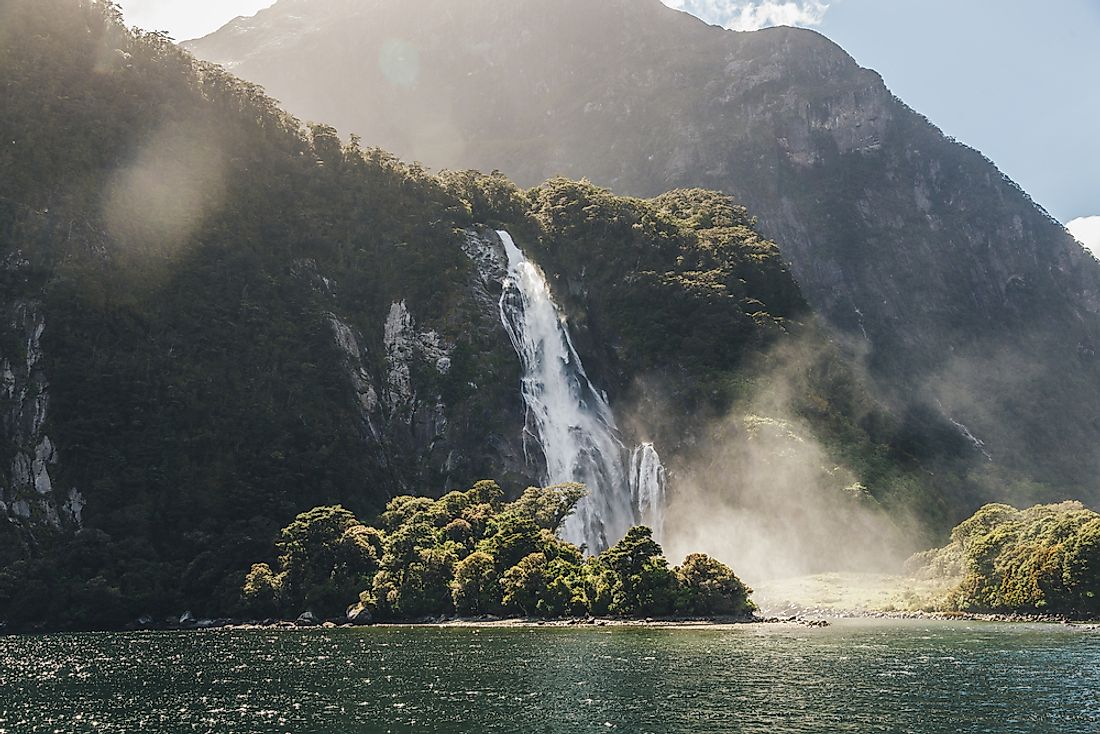Milford Sound, New Zealand - Unique Places Around The World

Milford Sound in New Zealand is the most iconic location in the country and one of the world’s top travel destinations. It is also the wettest part in New Zealand and among the wettest in the world receiving up to 7,000 mm of rain for about 183 days in a year.
Description
Milford Sound is a fiord located within the Fordland National Park. The fiord is located partly in the Piopiotahi Marine Reserve and partly in the world heritage site of Te Wahipounamu. John Grono, a Welsh sealing captain, named the Milford Sound after his birthplace Milford Haven. The sound was given as Piopiotahi by the Maori after the thrush-like and extinct Piopio bird. From the Tasman Sea at Dale Point, the sound runs 15 kilometers and is surrounded on both sides by rock faces rising 3,900 feet or more. The sound has two significant waterfalls, Lady Bowen falls and the Stirling falls. However, temporary falls form on the surrounding steep-sided rock faces during the rainy season. The falls dry off a few days after the rain stops.
Habitat
Milford area is one of the wettest parts of New Zealand with rainfall of up to 7 meters every year. The vegetation in the area is used to the heavy rain and snow especially that close to the mountains. A slightly drier environment is found in the eastern part of the mountain due to the rain shadow effect. Unlike the west side of the mountains where forests are abundant, the dry terraces east of Lake Te Anau are endowed with the fire modified shrublands of manuka, young beech, and bracken. On the Milford road towards the Eglinton Valley, the grand red beech is the dominant tree. Fuchsia, Hebe, and mountain ribbonwood grow on the open grounds that are the result of frequent snow avalanches. Occasional native conifers such as rimu rising above the silver beech can be seen as one descends into Milford Sound. Ferns, tree ferns, understory shrubs and mosses also thrive in the wet conditions.
Uniqueness
Scenic roads, peaceful cruises, well-marked traits and pellucid waters mark this breathtaking part of New Zealand’s South Island. The majestic Mitre peak that rises to 5,560 feet high is probably the most scenic part of the sound. It is made up of five separate peak clustering around a single arrow headed summit. Most people like to avoid the tricky climb in the area, but a daring few have attempted. The beautiful formation of the Mitre peak is a major attraction to photographers both professional and amateur. To adequately capture the grandeur and majesty of the mountain and convey the clarity of the air around has proved to be a futile effort even to professional photographers. The fiord is hundreds of feet deep and the runoff water creates a fresh water layer that is almost 20 feet deep sitting on top of the ocean. The runoff water carries tannins from the forest and stains the fresh water giving it a unique dark appearance.
Tourism
Despite being located in a remote area, Milford Sound is one of the most visited tourist destinations in New Zealand receiving between 550,000 and 1 million people every year. Several companies offer boat rides to the visitors departing from the Milford Sound visitor’s center. The boat rides last about one or two hours although some companies offer overnight boat rides. Some water sports such as canoeing and tramping are also available. Tourists can also view the Fiords unique marine environment at the Milford Discovery and Underwater Observatory located on the northern side of the fiord at Harrison’s Cove. The viewing is done at a depth of 10 meters. The underwater observatory is situated in the Piopiotahi Marine Reserve. It is possible to view deep-water animals such as black coral in the shallow waters around the conservatory due to a natural phenomenon called ‘deep water emergence.' Throughout Milford Sound and Fiord land, the black corals can thrive near the surface due to the cold temperatures and a brown stained, dark surface layer of fresh water. The brown stain is due to tannins from the forests around the area. During stormy days, powerful winds go upward while meeting the cliff face, forcing the water from waterfalls with a vertical drop to move upward. This wind play creates a unique and spectacular view for tourists.
Threats
Sometime back, some unique species were found around the beach forests in the Eglinton Valley. This unique flora and fauna, however, face predation from rodents and stoats. In the years 1999 and 2001, predator plaques hit the Eglinton Valley causing drastic reductions in the numbers of the species. DOC has run intensive pest control from that time to safeguard the native species. The Eglinton River faces threats from overgrowing of plants like lupines that have been introduced in the area and also from predation from introduced animals. Many species such as the black-fronted terns have their home in the Eglinton River.







